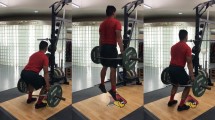Abstract.
A model has recently been proposed to predict the changes of mechanical power (\(\dot W \) ) during a maximal explosive effort (such as a standing high jump off both feet) following an adaptation (e.g. training/de-training). The model is based on the assumption that, all other things being equal (ceteris paribus), the predicted changes in \(\dot W \) depend on the measured changes of muscle force (F) or cross-sectional area (CSA) only. It follows that, if the measured changes in \(\dot W \) are not equal to those predicted by the model, factors other than a change in F (or CSA) must be responsible for this difference. The model does not allow the determination of factors specifically involved in the adaptation process but it helps in discriminating whether an adaptation has taken place at a local level (when the observed changes in F would be attributed to factors other than the observed changes in CSA, e.g. co-contractions, fibre type modifications...), or at a central level (when the observed changes in \(\dot W \) would be attributed to other factors than the observed changes in F, e.g. co-ordination of multiple joints and muscle groups...), or in both regions. In this paper the model has been applied to data reported in the literature on disuse (BR, bed rest), de-conditioning (SF, space flight), strength training (ST) and de-training (DT). The results of these calculations have confirmed previous observations on the determinants of the adaptation process and further suggest: (1) that training for one specific motor task (e.g. ST) could affect the performance of a second task (e.g. a maximal explosive jump) but that, as soon as the trained motor task is terminated (DT), this ability is re-gained; and (2) that neuromuscular impairment in disuse (BR) is closer to de-training than to the de-conditioning brought about by weightlessness (SF).
Similar content being viewed by others
Author information
Authors and Affiliations
Additional information
Electronic Publication
Rights and permissions
About this article
Cite this article
Zamparo, .P., Minetti, .A. & di Prampero, .P. Interplay among the changes of muscle strength, cross-sectional area and maximal explosive power: theory and facts. Eur J Appl Physiol 88, 193–202 (2002). https://doi.org/10.1007/s00421-002-0691-4
Accepted:
Issue Date:
DOI: https://doi.org/10.1007/s00421-002-0691-4




